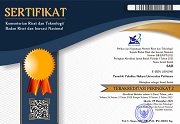Bilateral Kinship and Inheritance Distribution in Dayak Indramayu Customary Law
 )
)
(1) Faculty of Sharia, Universitas Islam Negeri Siber Syekh Nurjati Cirebon, Cirebon, Indonesia
(2) Faculty of Sharia, Universitas Islam Negeri Siber Syekh Nurjati Cirebon, Cirebon, Indonesia

(3) Faculty of Sharia, Universitas Islam Negeri Siber Syekh Nurjati Cirebon, Cirebon, Indonesia

(4) Faculty of Sharia, Universitas Islam Negeri Siber Syekh Nurjati Cirebon, Cirebon, Indonesia
(5) Faculty of Sharia, Universitas Islam Negeri Siber Syekh Nurjati Cirebon, Cirebon, Indonesia
(6) Al Musthafa Internasional University, Qom, Iran, Islamic Republic of
 Corresponding Author
Corresponding Author
Abstract
Introduction: The kinship system in the Dayak Indramayu community plays an important role in determining the pattern of inheritance distribution. Unlike the patrilineal or matrilineal systems, which emphasize a single line of descent, the Dayak Indramayu community adheres to a bilateral kinship system that allows inheritance rights to be obtained from both the father and mother.
Purposes of the Research: This study aims to analyze how the bilateral kinship system influences the pattern of inheritance distribution in the Dayak Indramayu community, emphasizing aspects of gender equality, recognition of adopted children, and its implications for social justice within the framework of customary law and national law.
Methods of the Research: This study uses a qualitative-descriptive method with a socio-cultural legal approach. Data was collected through field observations, semi-structured interviews with traditional leaders and community members, and documentation studies. Data analysis was conducted using Miles and Huberman's interactive model, supplemented with normative-legal interpretations to understand the relationship between traditional norms, social values, and positive law.
Results of the Research: The study found that the bilateral kinship system of the Dayak Indramayu produces a relatively egalitarian inheritance pattern by granting equal rights to both sons and daughters. However, there are still weaknesses in guaranteeing the rights of adopted children and the potential for conflict due to differences in interpretation between subgroups. The originality of this research lies in its recommendation to reformulate customary law to be more adaptive to contemporary principles of social justice and in line with the national legal framework.Keywords
DOI
10.47268/sasi.v31i4.3365
Published
2025-11-12
How To Cite
@article{SASI3365,
author = {Hamzah Fansuri and Edy Setyawan and Achmad Busthomi and Nur Ali and Dede Al Mustaqim and Rahman Dahlan},
title = {Bilateral Kinship and Inheritance Distribution in Dayak Indramayu Customary Law},
journal = {SASI},
volume = {31},
number = {4},
year = {2025},
keywords = {Customary Law; Bilateral Kinship; Inheritance; Social Justice.},
abstract = {Introduction: The kinship system in the Dayak Indramayu community plays an important role in determining the pattern of inheritance distribution. Unlike the patrilineal or matrilineal systems, which emphasize a single line of descent, the Dayak Indramayu community adheres to a bilateral kinship system that allows inheritance rights to be obtained from both the father and mother.Purposes of the Research: This study aims to analyze how the bilateral kinship system influences the pattern of inheritance distribution in the Dayak Indramayu community, emphasizing aspects of gender equality, recognition of adopted children, and its implications for social justice within the framework of customary law and national law.Methods of the Research: This study uses a qualitative-descriptive method with a socio-cultural legal approach. Data was collected through field observations, semi-structured interviews with traditional leaders and community members, and documentation studies. Data analysis was conducted using Miles and Huberman's interactive model, supplemented with normative-legal interpretations to understand the relationship between traditional norms, social values, and positive law.Results of the Research: The study found that the bilateral kinship system of the Dayak Indramayu produces a relatively egalitarian inheritance pattern by granting equal rights to both sons and daughters. However, there are still weaknesses in guaranteeing the rights of adopted children and the potential for conflict due to differences in interpretation between subgroups. The originality of this research lies in its recommendation to reformulate customary law to be more adaptive to contemporary principles of social justice and in line with the national legal framework.},
issn = {2614-2961}, pages = {406--418} doi = {10.47268/sasi.v31i4.3365},
url = {https://fhukum.unpatti.ac.id/jurnal/sasi/article/view/3365}
}
Amili, Halisma. “Analisis Hukum Terhadap Diskriminasi Gender Dalam Ketentuan Perundang-Undangan Indonesia.” Jurnal Kolaboratif Sains 8, no. 7 (2025): 4427–42.
Chandra, Febrian, Mohammad Arqon, Rizki Apriadi Bahri, and Muhammad Fachrul Al Jamili. “Ritual Adat Sebagai Instrumen Hukum Tidak Tertulis Masyarakat Jambi Dalam Persfektif Filsafat Hukum.” Legalitas: Jurnal Hukum 16, no. 2 (2024): 122–32.
Geertz, Clifford. Local Knowledge: Further Essays in Interpretive Anthropology. New York: Basic Books, 1983.
Haq, Hilman Syahrial. “Legal Pluralism and Inheritance Rights: Resolving Conflicts between Local Customs and National Law in Indonesia.” Kosmik Hukum 25, no. 1 (2025): 148–59.
Hazairin. Hukum Kewarisan Bilateral Menurut Al-Qur’an. Jakarta: Tintamas, 1964.
Karvatska, Svitlana. “Socio-Historical Factors of Law Perception in ‘Living Law’ Concept by Eugen Ehrlich.” Ehrlich’s Journal, no. 1 (2017): 42–51.
Kim, Marie Seong-Hak. “Legal Pluralism That Wasn’t: State and the Plurality of Law in Late Medieval and Early Modern Europe.” Tijdschrift Voor Rechtsgeschiedenis/Revue d’histoire Du Droit/The Legal History Review 93, no. 1–2 (2025): 130–67.
Kirunda, James, Helen Nabirye, and Ronald Muwanguzi. “Legal Pluralism in Postcolonial Nations: Reconciling Customary, Religious, and State Norms in Judicial Practices.” Rechtsnormen: Journal of Law 3, no. 2 (2025): 199–208.
Koentjaraningrat. Pengantar Ilmu Antropologi. Jakarta: Rineka Cipta, 2009.
Manse, Maarten. “The Plural Legacies of Legal Pluralism: Local Practices and Contestations of Customary Law in Late Colonial Indonesia.” Legal Pluralism and Critical Social Analysis 56, no. 3 (2024): 328–48.
Marselino, Fernando, Andika Wijaya, and Satriya Nugraha. “Inheritance Distribution under Dayak Ngaju Customary Law in the Kedamangan of Jekan Raya, Palangka Raya City (A Case Study of the Decision of the Kedamangan of Jekan Raya District, Palangka Raya City Number 056/DKA-KJR/V/2022).” Journal of Law, Politic and Humanities 5, no. 6 (2025): 4227–35.
Muharman, Dedy. “The Effectiveness of Customary Law in Resolving Land Disputes in Rural Areas: Social and Legal Perspectives in the Modern Era.” Journal of the American Institute 2, no. 4 (2025): 597–607.
Nusantara, Rian Hidayatulloh Garuda, and Nadhif Tanzil Haikal Harahap. “Filsafat Hukum Dan Keadilan Sosial: Analisis Teoritis Tentang Peran Hukum Dalam Mewujudkan Kesejahteraan Masyaraka.” Nusantara: Jurnal Pendidikan, Seni, Sains Dan Sosial Humaniora 3, no. 01 (2025).
Rahardjo, Satjipto. Hukum Dan Masyarakat. Bandung: Angkasa, 1980.
Rumkel, Nam, and Muhamad Taufik La Ode. “Justice Of Inheritance Rights For Women In Sahu Tribe Customary Law: A Comparative Study And Efforts Toward Harmonization.” Cepalo 9, no. 1 (2025): 53–68.
Satory, Agus, Sufmi Dasco Ahmad, Dewa Gede Edi Praditha, and Dedy Muharman. “The Role of Customary Law in Land Dispute Resolution in Rural Areas: Challenges and Prospects in the Modern Era.” Journal of the American Institute 2, no. 4 (2025): 511–22.
Seminario, César Bazán. “Decolonising Legal Theory: The Rule of Law and the Legalisation of Legal Pluralism.” Revista Via Iuris, no. 36 (2024): 38–67.
Siregar, Bismar. “Living Law Dan Dinamika Sosial: Integrasi Nilai-Nilai Kearifan Lokal Ke Dalam Hukum Nasional.” Lex Lectio Law Journal 4, no. 1 (2025): 14–28.
Sistyawan, Dwanda Julisa, Retno Saraswati, Lita A L W Tyesta, Marcellus Jayawibawa, and Mohammad Syaiful Aris. “The Development of Positivism’s Legal Theory: From Bentham to Hart.” Petita 9 (2024): 777.
Soepomo. Bab-Bab Tentang Hukum Adat. Jakarta: Pradnya Paramita, 1982.
Suteki, Galang Taufani. Metodologi Penelitian Hukum (Filsafat, Teori Dan Praktik). Depok: PT Radja Grafindo Persada, 2018.
Zulfikar, Mochamad Aditya, Nanda Sonia Salsabila, and Erlita Karisma Ariditya. “The Existence of Civil Law amidst the Embeddedness of Customary Law (Living Law) in Indonesia.” In-Prolegurit 3, no. 1 (2024): 104–16.| Dublin Core | PKP Metadata Items | Metadata for this Document | |
| 1. | Title | Title of document | Bilateral Kinship and Inheritance Distribution in Dayak Indramayu Customary Law |
| 2. | Creator | Author's name, affiliation, country | Hamzah Fansuri; Faculty of Sharia, Universitas Islam Negeri Siber Syekh Nurjati Cirebon, Cirebon; Indonesia |
| 2. | Creator | Author's name, affiliation, country |
Edy Setyawan; Faculty of Sharia, Universitas Islam Negeri Siber Syekh Nurjati Cirebon, Cirebon; Indonesia  |
| 2. | Creator | Author's name, affiliation, country |
Achmad Otong Busthomi; Faculty of Sharia, Universitas Islam Negeri Siber Syekh Nurjati Cirebon, Cirebon; Indonesia  |
| 2. | Creator | Author's name, affiliation, country | Nur Ali; Faculty of Sharia, Universitas Islam Negeri Siber Syekh Nurjati Cirebon, Cirebon; Indonesia |
| 2. | Creator | Author's name, affiliation, country | Dede Al Mustaqim; Faculty of Sharia, Universitas Islam Negeri Siber Syekh Nurjati Cirebon, Cirebon; Indonesia |
| 2. | Creator | Author's name, affiliation, country | Rahman Dahlan; Al Musthafa Internasional University, Qom; Iran, Islamic Republic of |
| 3. | Subject | Discipline(s) | |
| 3. | Subject | Keyword(s) | Customary Law; Bilateral Kinship; Inheritance; Social Justice. |
| 4. | Description | Abstract | Introduction: The kinship system in the Dayak Indramayu community plays an important role in determining the pattern of inheritance distribution. Unlike the patrilineal or matrilineal systems, which emphasize a single line of descent, the Dayak Indramayu community adheres to a bilateral kinship system that allows inheritance rights to be obtained from both the father and mother.Purposes of the Research: This study aims to analyze how the bilateral kinship system influences the pattern of inheritance distribution in the Dayak Indramayu community, emphasizing aspects of gender equality, recognition of adopted children, and its implications for social justice within the framework of customary law and national law.Methods of the Research: This study uses a qualitative-descriptive method with a socio-cultural legal approach. Data was collected through field observations, semi-structured interviews with traditional leaders and community members, and documentation studies. Data analysis was conducted using Miles and Huberman's interactive model, supplemented with normative-legal interpretations to understand the relationship between traditional norms, social values, and positive law.Results of the Research: The study found that the bilateral kinship system of the Dayak Indramayu produces a relatively egalitarian inheritance pattern by granting equal rights to both sons and daughters. However, there are still weaknesses in guaranteeing the rights of adopted children and the potential for conflict due to differences in interpretation between subgroups. The originality of this research lies in its recommendation to reformulate customary law to be more adaptive to contemporary principles of social justice and in line with the national legal framework. |
| 5. | Publisher | Organizing agency, location | Faculty of Law, Universitas Pattimura |
| 6. | Contributor | Sponsor(s) | |
| 7. | Date | (YYYY-MM-DD) | 2025-11-12 |
| 8. | Type | Status & genre | Peer-reviewed Article |
| 8. | Type | Type | |
| 9. | Format | File format | |
| 10. | Identifier | Uniform Resource Identifier | https://fhukum.unpatti.ac.id/jurnal/sasi/article/view/3365 |
| 10. | Identifier | Digital Object Identifier | 10.47268/sasi.v31i4.3365 |
| 11. | Source | Title; vol., no. (year) | SASI; Volume 31 Issue 4, December 2025 |
| 12. | Language | English=en | en |
| 13. | Relation | Supp. Files |
Untitled (4MB) |
| 14. | Coverage | Geo-spatial location, chronological period, research sample (gender, age, etc.) | |
| 15. | Rights | Copyright and permissions | Copyright: Authors who publish their manuscripts in this Journal agree to the following conditions: 1. The copyright in each article belongs to the author, as well as the right to patent. 2. Authors can enter into separate, additional contractual arrangements for the non-exclusive distribution of the journal's published version of the work (e.g., post it to an institutional repository or publish it in a book), with an acknowledgment of its initial publication in this journal. 3. Authors are permitted and encouraged to post their work online (e.g., in institutional repositories or on their website) before and during the submission process, as it can lead to productive exchanges, as well as earlier and greater citation of published work. 4. Authors have the right to self-archiving of the article (Author Self-Archiving Policy)
License: The SASI Journal is disseminated based on the Creative Commons Attribution-NonCommercial 4.0 International license terms. This license allows anyone to copy and redistribute this material in any form or format, compose, modify, and make derivatives of this material for any purpose. You cannot use this material for commercial purposes. You must specify an appropriate name, include a link to the license, and certify that any changes have been made. You can do this in a way that is appropriate but does not imply that the licensor supports you or your use.
|
Copyright (c) 2025 Hamzah Fansuri, Edy Setyawan, Achmad Otong Busthomi, Nur Ali, Dede Al Mustaqim, Rahman Dahlan

This work is licensed under a Creative Commons Attribution-NonCommercial 4.0 International License.

 : 417 times
: 417 times Download : 189 times
Download : 189 times
















